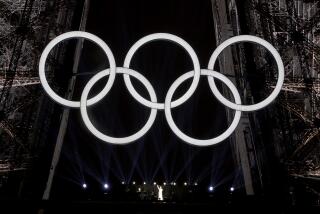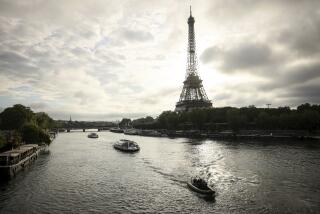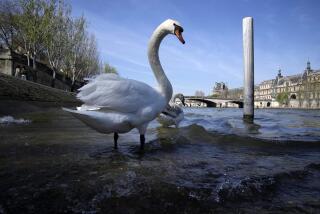Floating at Large on a Barge on the Paris Canals
- Share via
PARIS — When foot-weary from museum sauntering, enchanting though the sights may be, and when your stomach is rebellious from overindulgence in food and drink (always so beguiling here), try a barge.
For a lazy respite and something just a bit different while in Paris, on a barge trip along the Canal St. Martin you get the pleasure of Steven Zade’s company.
Zade is a jolly, gregarious 44-year-old Englishman who lives here and cherishes an unsung aspect of this lovely old city that most tourists, and even many Parisians, never encounter: the meandering canals of Paris, of which there are three--the St. Martin, the St. Denis and the Our.
All three join at the Villette Basin, a man-made harbor near the the center of Paris that opened in 1806, was expanded in 1825 and by 1900 made the French capital the nation’s fourth-busiest port after Marseille, Le Havre and Bordeaux. Because the basin rises 80 feet above the Seine it can be reached from each canal only through a series of locks.
Of the three canals, the St. Martin--which opened early in the 19th Century and which runs from the downstream side of the basin to the Seine--is by far the most popular, partly because of its nine picturesque locks and partly because it winds about three miles through charming tree-lined neighborhoods to an exquisite tryst with the Seine, near some of the ancient river’s most captivating landmarks.
It also is the canal on which Zade does his stuff, as tour guide on La Patache, a 65-passenger, 18-meter catamaran that travels the length of the canal and, for a brief time, along a memorable portion of the Seine River. The vessel also is playfully called the eautobus because of the watery route along which it chugs every day from April 7 to Nov. 10--except on bank holidays, when the locks are closed.
The craft makes the three-hour trip between the river and the basin twice daily, once in each direction. Mornings, it departs from a quay along the Seine at 9:30 and disembarks at the basin at 12:30 p.m. The afternoon trip starts at 2:30 and ends at the Seine-side pier at 5:30. We chose the afternoon trip.
The nonstop commentary of Steven Zade, a short, cherub-faced man with an infectious sense of humor, was no small part of the outing’s appeal. He wears round, steel-rim glasses, an old-fashioned cap over his dark, shoulder-length hair, plus a black bow tie, white shirt and cord trousers, all of which give him the appearance of a merry, perhaps slightly daft, professor.
Zade is facile in both French and English. During the pokey run from the basin to the river he maintained an encyclopedic patter, providing information in both languages, not only about the canal’s history and special features but also the distractions along its banks.
Locks of the Dead
Consider this bit, if you will:
The third and fourth locks are known as the Ecluse de Morts (Locks of the Dead). Why? Well, explained Zade, feigning a shudder, while the canal was being built, workmen unearthed a cemetery from the Merovingian period, a time when a Frankish dynasty ruled what is now France from about AD 500 to AD 750.
Zade, a canal jack-of-all trades, does just about everything aboard the Patache except pilot it--although if called upon he probably could do that with the same flair with which he amuses passengers with his antics and breezy commentary.
When the craft arrived at a lock, for instance, as frequently as not Zade leaped from the vessel and embraced the tenders with bubbling enthusiasm. He has been known to exchange a toast with them, something that would be forbidden even among the most daring of his flock because it is against the law for passengers to leave the vessel during the trip.
Zade conducts most of his lectures while straddling a boat railing, along which he moves constantly, switching from one language to another and agile as a monkey. The perch on the rail serves Zade well because of the configuration of the barge, which has a substantial interior saloon that goes largely unused although it has benches and, happily, possesses a toilet.
Most passengers select chairs under a huge awning at the front of the craft. So if Zade is not to trample his listeners, or be trampled, the rail is his best means of conveyance.
(Note of caution: Despite the awning, wear a hat during the trip. The sun was withering on the afternoon we were aboard.)
About halfway through the voyage Zade metamorphoses into a bartender, selling soft drinks, beer and wine. A tonic water cost 6 francs.
On the day we were aboard about two-thirds of the tourists appeared to be French. Most were family groups visiting Paris from the hinterlands. The remainder appeared evenly split between British and American sightseers.
The voyage is not for the impatient. Going from lock to lock is a slow process, as is the wait for the gadgets to transport the Patache from one water level to another.
Some of the children grew restless during the trip, and gave their parents fits. But most travelers adjust just fine and relax as they watch picnickers, fishermen and painters along the bank, as well as strolling lovers and even some plain old bums who lounge on quayside benches and sometimes salute the voyagers with a wave of a wine bottle.
People Stare Back
Parisians, in turn, gape and gander back. Some stare down on the Patache and its strange cargo from arcing bridges that carry streets and sidewalks across the canal.
About 45 minutes before the trip’s end the craft disappeared into a long tunnel and traveled through its gloom for perhaps a mile and a half. It was an eerie experience, made more so because Zade chose those moments to serenade his flock on the clarinet. “I thought you played the flute,” one passenger said.
“That was last year,” he answered, scarcely missing a note, as we slipped through a creepy half light that filtered down from grated openings in the tunnel’s roof while sunlight cast shafts of brilliance on the water. We could look up and see the blue sky and tree tops through the grates.
Smart New Marina
Upon leaving the final lock and emerging into the light again, we passed a smart new marina, the Port de Plaisance de Paris-Arsenal which, said Zade, can accommodate upward of 200 pleasure craft. The banks are landscaped with trees, flowers and shrubs growing abundantly in lovely terraced gardens.
Once on the Seine we picked up speed. And because sunbathers on the nearest bank were less than decorous, that was probably just as well for some of the more timorous folks on board.
Heading toward our docking site, the Quai Anatole-France near the Solferino Metro stop from where the morning trip leaves, we got a different view from most tourists of some of the fabled sights that ennoble the banks of the Seine: the Ile de la Cite, Notre Dame, the Ile St. Louis and historic bridges.
The cost: 80 francs (about $13 U.S.); children under 12, 40 francs. Literature about the trip is in most hotels and travel agencies; the Michelin Guide also carries information on it. We were told, however, that embarkations and destinations are sometimes erratic. Best advice is to call the main office for information about exact times and point of departure.
We are told that the operators speak English as well as French. The number in Paris: 874-75-30.
More to Read
Sign up for The Wild
We’ll help you find the best places to hike, bike and run, as well as the perfect silent spots for meditation and yoga.
You may occasionally receive promotional content from the Los Angeles Times.






